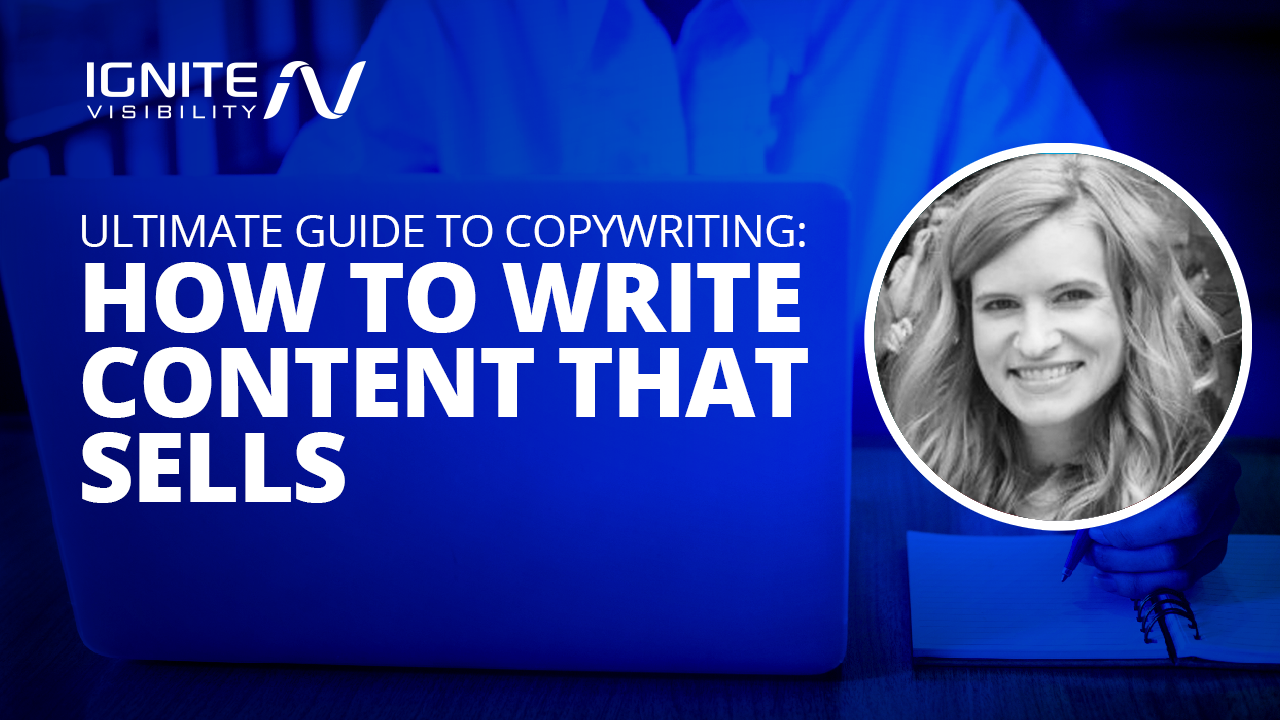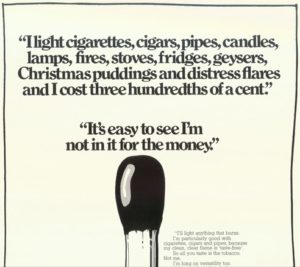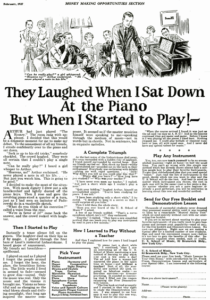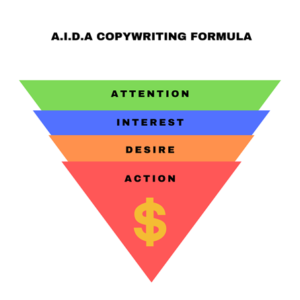
Do you hear that?
Crickets.
That’s the sound your proverbial cash register is making because you haven’t invested in copywriting.
Want to hear that register sing? Your first step is right here.
Start with this comprehensive crash course on copywriting for more customers, more revenue, and more potential.
Let’s get writing.
How to Use This Copywriting Guide
Inside this guide, you’ll find the step-by-step process for using words on a page to make more sales.
Read it now, and bookmark it for later.
- The Basics: What is Copywriting?
- The Customer: Who’s Who?
- The Magic: Finding the Right Copywriting Formulas
- The Secret Sauce: Tips to Help You Go Above and Beyond
- The Finisher: How to Edit Like Hemingway
What Exactly is Copywriting?
Let’s start by talking about what copywriting isn’t.
It isn’t a book, a blog post, or even a really well-placed Instagram caption.
It’s writing that sells.
It’s writing intended to convince consumers to take a specific action. And when done well, it moves users to buy, hit subscribe, or opt-in to your business offer.

Customer browsing tech products with copy featured at the top of the page
Persuasive writing takes years to master and includes plenty of work behind the scenes. We’ll explore these details later on, but for now, remember that good copywriting:
- Generates clicks
- Convinces you to “add to cart”
- Enforces the need for problem-solving products and services
Types of Copywriting
You might find copywriting in any of the following sources.
- Website copy (homepages, side pages, etc.)
- Ads (digital, print, social media)
- Sales pages
- Email marketing campaigns
- Landing Pages
- Calls-to-action
What do these things have in common? Their purpose is clearly defined – and it’s always designed to move the reader to the next step in the sales process.
In the best forms of copywriting, the buyer may not even realize they’re being sold until they’ve hit the buy button.
But here’s the thing.
Copy is not simply words on a page. Copywriting is a professional communication skill that takes years to master.
But if your goal is to land more sales or convert more users, it’s well worth the investment.

Example of a vintage advertisement for matches that uses persuasive copy
Copywriting, Content Writing, and Content Marketing–What’s the Difference?
When it comes to marketing and writing, there are three major players. Don’t let the lingo fool you; the differences in each type of writing are important.
- Copywriting– Persuasive, inspirational, or motivational writing that encourages potential buyers and customers to follow through on an offer.
- Content Writing– A mixture of written mediums for the web, which can include everything from blogs to infographics, eBooks, and more.
- Content Marketing– The collective and comprehensive strategy for using content for the purpose of selling a product or service. A full-fledged content marketing plan should involve different types of content, layers of testing, and worthwhile metrics.
Finding “Voice of Customer” Data
Finding the “voice of customer” data is perhaps the single most important step in the copywriting process.
But what is “voice of customer” data? It’s actually quite simple.
The “voice of customer” refers to your ideal buyer’s opinions, experiences, and expectations. It’s what the customer would say behind closed doors if they were describing your product to a friend or colleague.
VOC data helps you, as a copywriter, get inside the head of your ideal buyer. When you know what the customer needs and craves, you can deliver copy that compels them to click.
Why Do You Need VOC Data for Copywriting?
VOC data helps you specifically address pain points and agitations. What issues frustrate your customer, and what solutions would solve that irritation?
This data also helps you pinpoint “sticky” language that truly resonates. Remember, copywriting isn’t fluff; it’s intentional language that inspires specific action.
With VOC data on hand, you can better understand the goal or outcome that your product helps the customer achieve. And by using their voice in your copy – by incorporating their opinions, fears, agitations, and frustrations – they’ll see themselves reflected on the page. You’ll be the brand that “gets” them. You’ll also be the brand they see as most qualified to deliver their dream state, which is the solution to that fear that your product or service delivers. you’ll be able to create an “aha” moment for your customer.
Take this legendary ad by John Caples:
“They laughed when I sat down at the piano – but when I started to play!”

John Caples Advertisement
It’s far from the keyword-heavy headlines you see in Google Ads, but it will go down in history as one of the most successful ad campaigns to ever hit the papers.
Why?
Simple: it draws on emotion. It taps into the deepest desires – and fears – of the target audience. Everyone’s afraid to be laughed at – and everyone wants to prove their peers wrong. Caples captured that story perfectly in a headline.
We all have secret emotional desires. The most effective copy taps into those desires. Remember, we don’t buy on logic alone. We buy first with emotion and then justify it with logic.
And to understand the kind of emotions and desires you must tap into, you need to go straight to the source – your ideal customer.
Fortunately, when it comes to VOC data, you don’t have to start from scratch. Here are a few ways to locate, use, and leverage voice of customer data for better copywriting.
Review Mining
Customers love to share what they think about products and services. As a copywriter, this information is fuel to your wordsmithing fire.
Joanna Wiebe of Copyhackers, a trusted expert on all things copywriting, advises using reviews to define your ideal customer and target audience.
Don’t be shy. Public testimonials are amazing sources of customer experiences and expectations. You can find these reviews in places like:
- Amazon product reviews
- Reddit threads
- Facebook groups
While you should always make sure that it aligns with overall brand messaging, don’t be afraid to pluck compelling words and phrases, or “sticky” language, from a few of the most dynamic reviews.
Customer Surveys and Interviews
Depending on your customer base and how closely you work with certain customers, you have two options for collecting direct feedback.
- Surveys can be distributed broadly to large portions of your mailing or customer list at one time. Some responses may be more generic, but depending on your survey design, surveys can lead to helpful insights.
- Interviews are more personal and tailored to specific customers. The downside is that interviews require more time. If you have high-profile customers or want to get specific feedback, opt for this approach.
How Do You Use VOC Data in Your Copywriting?
When it comes to copywriting and customer data, don’t miss the connection. You aren’t exploring this information to be nosy; you’re purposefully researching with the intention of creating captivating sales material.
This means that you should use VOC data to write in a similar style that your customers understand and relate to.
For example, if you sell a software product and your market is beginner tech users, you don’t want to use fancy lingo and difficult jargon to sell them on the solution. They won’t know what your copy means, and their confusion will convince them that your offer doesn’t match their needs.
In this context, you would use VOC data to meet customers where they are in their tech journey.
Write using words that you find in their reviews of competing products. Counter some of their biggest hurdles and frustrations. Empathize with what they expect when they download or buy a new product.
Copywriting Formulas: Simple Steps to Convert More Readers
Here’s some good news: great copywriting rarely starts from scratch.
Some of the best in the biz rely on proven copywriting formulas to simplify the process. This includes formulas for different areas of text located on pages, advertisements, or emails.
Headline Formulas
Headlines can make or break your copywriting. Why is that? According to expert copywriters, up to five times as many people read the headline as they do body copy.
Headlines are the eye-catching elements at the top of a page or section. They communicate the page’s primary purpose and why readers should care enough to keep scrolling.
Copywriters put lots of pressure on the ability to craft strong headlines. While some of this pressure is warranted, there’s no need to reinvent the wheel.
An industry leader in professional marketing writing, Copyhackers shares several common headline formulas that create maximum impact. Check out these templates for inspiration:
- A competitor [does this undesirable thing] but, [your brand name] [does this highly desirable thing]
Ex. While Pepsi goes flat, Coke’s bubbles keep on dancing.
- [Service Name] is a [service category] that offers [amazing outcome for end users or decision-makers] without [common objection, pain point, or anxiety]
Ex. The Cloud is a virtual filing cabinet that offers limitless storage for everything – without having to remember where you put it.
- For [target customer] who [statement of need or opportunity], [your brand name] is [product category] that [statement of benefit not found elsewhere]
Ex. For the athlete tired of dishing out for multiple shoes, Nobull is the footwear that combines trainers and runners in one.
- They all [did this unpleasant thing] when [unexpected thing], but then [ideal result of using unexpected thing]!
Ex. They all laughed when he sat down at the piano, but then he started to play!
- You’re tired of [objection, pain point, or anxiety], but you [desired outcome]. So it’s time you met [your product name]
Ex. You’re tired of juggling bank accounts, credit cards, and budgeting, but you need to keep track of your cash flow. So it’s time you met Mint.
Notice how in each of these examples, the writer is leveraging emotional language and future states to depict what the buyer needs or is missing out on currently.
General Webpage Formulas
Now that you’ve got what it takes to craft a killer headline, let’s talk about web page copy.
Generally speaking, full web pages provide more text and body copy for the reader or future customer. It’s vital to keep readers interested all the way to the bottom of the page.
You can make that happen by using one of two popular copywriting formulas: PAS and AIDA.
PAS
PAS is a simple sales formula known for high conversion rates and convincing prospects to take action. As with many other formulas, the letters are an acronym used to describe each step in the formula.
- P (Problem) – Get detailed about the problem that your future customer or client is experiencing. Where are they in their current journey?
- A (Agitation) – Here’s where you’ve got to get really Use intense imagery and descriptions to drive the point home. Their problem is serious, and they need a fix.
- S (Solution) – Your solution should solve the problem and soothe the agitation. It should be very clear how the dots connect to bring the problem full circle. The buyer should be able to sigh with relief that they’ve finally discovered the answer to their need.
PAS has many variations, and copywriters put their spin on this basic formula all the time. Don’t be afraid to use your own creativity, brand messaging, or customer research to hit the right nerves in your target market.
AIDA
AIDA is a popular copywriting formula that also has many variations and nuances. But there’s a reason that writers flock to the original concept–it works.
Here’s the acronym broken down:
- A (Attention) – As readers and customers, we’re bombarded with content. To grab someone’s attention, you have to invoke focused interest. This step relies on your ability to know your customer and how you can best “interrupt” their average routine.
- I (Interest) – Once you’ve captured their attention, you have to provide something for them to chew on. Introduce new ideas and concepts that cause them to think about what could be.
- D (Desire) – What does your target customer really crave? In this step, you need to dangle the proverbial carrot in front of their nose. Their mind and heart should be ready and willing to jump at your offer.
- A (Action) – What do you want the buyer to do next? Don’t leave them guessing. No matter how simple it might seem, spell out the specific action you want your audience to take after they interact with your content.

The AIDA Formula in Action
The AIDA formula reminds us that as copywriters, we have to get to the heart of the matter.
No matter how proven your methodology is or how many times a certain formula has worked in the past, understanding who your customer is and what makes them tick will allow you to produce better, more targeted copy.
Additional Copywriting Tips
Even with formulas in your copywriting tool belt, you need more than a “plug and play” solution. There are several tips to keep in mind for maximizing conversion every single time.
Write to One Reader (And Only One)
As a copywriter, you should always write like you’re addressing one person and one person only. Remember: When you try to write for everyone, you end up convincing no one.
Use the word “you” generously throughout your copy. This adds a personal twist and hits the reader right at home, making them feel and experience your words as if they were meant for them alone.
You may experiment with different versions of this approach, including replacing every first word of each sentence with “you.” This tactic will give you a good idea of how “you”-focused your copy is and allow you to adjust future drafts as needed.
Call To Action–Reminders for Strong CTAs
In the world of copywriting, each web page, email, advertisement, or other form of copy should only have one purpose.
Don’t overcrowd your copy or confuse your readers by asking them to do more than one thing. Chances are, they’ll stop or get lost after the first step.
As a copywriter, decide the logical next step or action and make it the focus of your page. The page’s entire job is to get the reader to take that next step.
That’s where your clear CTA comes into play.
Resist the urge to use flashy language here. In this step, you’re not trying to impress–you’re trying to convert. If the next step is “Enter Your Email”, that’s all you need to say.
That said, don’t underestimate the power of language in your CTA. This is another opportunity to create desire.
Rule of thumb: when crafting CTA’s, try to answer the sentence “I want to…” or “I want you to…”. For example, if I wanted you to download this article, you might think “I want to learn how to make money with words. My CTA, then, would be “Learn How to Make Money With Words.”
Try to avoid friction words whenever possible. Anything that implies work will deter your customer from clicking. Those words include “submit,” “buy,” “sign up,” and “complete”.
Persuasion Techniques for More Compelling Copywriting
Even though persuasion is a critical part of copywriting, the ability to persuade doesn’t always come naturally. Experienced copywriters are constantly refining their persuasive abilities and adjusting their chosen techniques.
Haven’t hit peak persuasion? No worries.
Thanks to copywriting pioneers, there are proven principles that work to sway your audience and convince prospective buyers to take action.
Cialdini’s 6 Principles of Persuasion
Dr. Robert Cialdini is the Professor Emeritus of Psychology and Marketing at Arizona State University.
After years of studying human behavior as it relates to marketing and purchasing choices, Dr. Cialdini offers six top principles that can help you level up your copywriting by incorporating psychological triggers:
- Reciprocity – This principle refers to the notion that most people take action in response to a reciprocal action. In terms of copywriting for business audiences, this means that if you offer a free piece of content, prospects will be more likely to exchange their contact information for what you’re offering.
- Scarcity – Buyers respond well to limited-time offers and exclusive deals. If there’s the possibility that they won’t be able to receive something at a future time, the urgency is there to act now.
- Authority – As you write copy, remember to speak as though you are the expert in whatever it is you make, offer, or sell. People want to buy from authorities they can trust, not from novice sellers who lack confidence.
- Consistency – Human behavior is often habitual. According to Cialdini, this is particularly true when convincing customers to buy. You may ask your buyers to make the same type of commitment or provide them with a similar offer so that they quickly recognize a past experience and act again.
- Liking – Whether we like it or not, many buyers like and trust people who are similar to them. If you’re a copywriter who knows your target audience, this principle means that you should speak in the tone and manner in which your audience likes.
- Consensus – Customers like knowing that others have gone before them and that popular opinion is in favor of a product or service. To use content, leverage things like testimonials, reviews, case studies, and other positive feedback. While you should never embellish consensus, you should be proactive to find and use the kinds of experiences that work in your favor.
The next time you sit down to write compelling copy, try to incorporate one or more of Dr. Cialdini’s principles.
Editing: Keep it Clear and Concise
If you’re a new copywriter worried about being creative enough to make the cut, don’t stress.
Rest assured that some of the most important aspects of copywriting are your intent and your clarity.
What does that mean? Well, regardless of how creative you can be, you must make sure that your message is obvious on the page and conveyed clearly to your audience.
Creativity, which might include plays on words or a sarcastic or humorous tone, should be reserved primarily for headings and subheadings.
No matter what kind of project you’re working on, it’s important that you take the time to edit for brevity and clarity. To get a head start, turn to one of the most recognizable names in writing–Earnest Hemingway.
Hemingway’s Rules on Writing
Ernest Hemingway is known as one of the greatest American writers in history and lived by four basic rules on writing.
Luckily for us, those rules apply directly to the copywriting process.
- Write in short sentences. Hemingway’s journalistic style contributed greatly to his success. This style, which eliminated the long and drawn-out prose that came before him, revolutionized the writing world. Short sentences are easier to read and more compelling.
- Stick to short paragraphs. Although Hemingway didn’t have access to digital and online sources, he was ahead of his time in predicting our attention spans. As humans, we’re more likely to read short, concise, and easy language.
- Use “vigorous” English. Hemingway’s vigor came from being passionate about his subjects, and he encouraged other writers to adopt the same enthusiasm. Surprisingly, this rarely came from a first draft. Hemingway believed in rewriting and editing so that true passion and focus would come through.
- Be positive. Hemingway knew that readers (and future customers) want to discover what something is, rather than what it isn’t. For copywriters, this means selling your product or service in the highest regard possible. Don’t call something “cheap” when you could describe it as “budget-friendly” or “economical.”
Sound simple? Let’s take a closer look at what Hemingway taught writers about the editing process.
Hemingway’s Rules on Editing
Hemingway had a natural gift for the written word, but that’s not to say he never refined his skills. In fact, Hemingway believed in improving one’s writing after the first draft was complete.
What does this mean for copywriters? Well, it means that while you shouldn’t be scared to get that first draft down, you should always revisit with careful editing.
The following are editing principles from Hemingway that modern copywriters can still use.
- Brevity: As you edit, remove several words when one word will suffice. Hemingway believed in short sentences with impact, not fluff full of distraction.
- Clarity: Be bold, but be clear. Use the editing process to address any inconsistencies or phrases that might confuse a potential customer. Prospective buyers that have to look elsewhere for their answer might not come back.
- Simplicity: The editing process should always result in simplification. Whether that yields shorter sentences, clearer paragraphs, or less confusing headlines–simplicity wins the day.
Putting it All Together
When you grasp the basic copywriting fundamentals, you’ll be equipped to tackle a variety of projects and assist businesses in their growth goals.
As we wrap up, here’s a breakdown of the steps you need to remember when writing strong copy.
- Start with customer research. Knowledge of who your customer is, where they are currently, and what they hope to have can make your copy shine. Always invest the time in understanding your customer, audience, and market.
- Pick the best formula for the content you’re creating. Headlines aren’t the same as body copy, and vice versa. Each kind of text on a page necessitates a different approach. Fortunately, proven copywriting formulas are there to back you up and provide a blueprint for successful writing.
- Include a clear next step (CTA). One of the main rules of copywriting is that you should never leave your customer guessing. It’s time to close the deal with an effective CTA. Whether that includes leaving an email, signing up for a webinar, or starting a free trial, always let your customer know what specific action to take next.
- Inject persuasion principles where possible. The power of persuasion is what sets copywriting apart from regular content writing. Persuasive techniques may take years to truly master, but beginners can get a jump start with simple persuasion tactics that really work.
- Edit like Hemingway. Unlock copywriting success by following in the footsteps of Hemingway. Writer powerfully, but write simply. Get your initial thoughts out there, but don’t shy away from editing with intentionality.
Frequently Asked Questions
To quickly round up the points shared in this article, we’ve compiled a list of the top copywriting questions that people want to know.
What is copywriting?
Copywriting is a type of writing for businesses that is persuasive in nature. Typically used in marketing and sales, copywriting helps future customers learn more about a product or service; the intended goal is to generate conversions or new sales.
Which businesses use copywriting?
Many different industries leverage copywriting strategies. While it’s a popular technique in business-to-business (B2B), any organization that caters to customers can take advantage of persuasive content. For copywriters, this means that the possibilities are nearly endless.
What are the advantages of copywriting?
There are numerous benefits to adding copywriting to your marketing strategy. Not only can you build better brand messaging, but copywriting allows you to establish an emotional connection with your target audience. Other advantages relate to search engine optimization (SEO), sales conversions, and discovering data about your ideal customer.
What is SEO copywriting?
SEO copywriting shares similar principles to regular copywriting with one key difference–the ability to rank highly on search engines. SEO copywriters use search engine strategy and keyword research to produce copy that allows businesses to appear in more organic searches at a higher rate.
How do I become a copywriter?
If you want to become a copywriter, there are plenty of ways to get started. While you’ll want to begin with some basic research and a training or prep course, you can also jump right in. Copywriters find success in full-time marketing positions, at marketing agencies, and as freelancers or independent consultants.
Wrapping Up–Write Your Way to Copywriting Success
As with any professional skill, copywriting takes practice to perfect. Many copywriters spend years honing their craft, working with different types of businesses and clients, and addressing several types of target audiences.
This cumulative experience allows copywriters to level up their persuasive game. But the best way to learn the art of good copy? Is to simply start writing.
No matter what stage of the copywriting journey you’re on, we invite you to explore the massive library of articles and resources at Ignite Visibility. Our digital marketing community is full of talented marketers, writers, and industry leaders who can help you visualize your next steps to copywriting success. Let’s get started…together!
